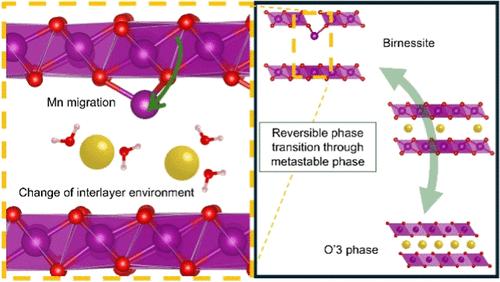Controlling Interlayer Disorder Toward Reversible Phase Transition in a Layered Sodium Manganese Oxide Cathode
IF 14.4
1区 化学
Q1 CHEMISTRY, MULTIDISCIPLINARY
引用次数: 0
Abstract
Sodium manganese oxides are promising Na-ion battery cathodes but they suffer from irreversible phase transitions during electrochemical reactions. Most strategies to date have aimed to suppress the phase transitions by stabilizing their layered structures through limiting the content of extractable Na+. Here, we conversely increase atomic disorder in the Na-birnessite, a layered sodium manganese oxide, and thereby modulate its phase transition behavior toward improved electrochemical reversibility. Our study reveals that Mn vacancies and Mn migrated into the interlayer affect interlayer local environment of Na+ and water molecules consequently enhancing Na+ mobility. We observe better capacity retention for disordered “D-Na-birnessite”, which undergoes a reversible phase transition from the birnessite-type structure to an O′3-type α-NaxMnO2-like structure through another intermediate metastable birnessite-type phase. This research highlights the positive effects of atomic disorder to regulate phase transition routes for achieving superior electrochemical reversibility, finally paving the way to overcoming the limits of layered oxide cathodes.

求助全文
约1分钟内获得全文
求助全文
来源期刊
CiteScore
24.40
自引率
6.00%
发文量
2398
审稿时长
1.6 months
期刊介绍:
The flagship journal of the American Chemical Society, known as the Journal of the American Chemical Society (JACS), has been a prestigious publication since its establishment in 1879. It holds a preeminent position in the field of chemistry and related interdisciplinary sciences. JACS is committed to disseminating cutting-edge research papers, covering a wide range of topics, and encompasses approximately 19,000 pages of Articles, Communications, and Perspectives annually. With a weekly publication frequency, JACS plays a vital role in advancing the field of chemistry by providing essential research.

 求助内容:
求助内容: 应助结果提醒方式:
应助结果提醒方式:


